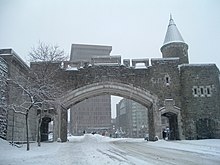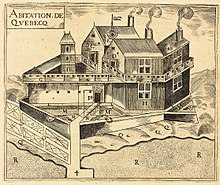Quebec City Walls
The city walls of Québec stood in the Canadian city founded in 1608 and capital of the province of the same name . They go back to the late phase of urban fortification. Its construction began between 1608 and 1690. Temporary fortifications were built in 1690 on the initiative of Louis de Buade , Count of Frontenac, in anticipation of an English attack . They originated around today's Upper Town, around 90 meters above the St. Lawrence River . As the attack by the English admiral William Phips in October 1690 showed, fortification of the city was urgently needed. The city fortifications were completed in 1745, but Québec became British as early as 1759. The new masters initially let the city wall fall into disrepair, but in the decades after the British-American War , which lasted from 1812 to 1815, the facilities were reinforced and expanded again. Towards the end of British rule, the city gates were closed, but their historical value was soon recognized and so the gates were rebuilt and the city walls restored. They have been a National Historic Site of Canada since 1985 and are on the UNESCO World Heritage List .
1608: founding phase
First efforts by the French to secure a place in the region go back to 1541, when Jacques Cartier had a fort built on Cap Rouge about 16 km west of what is now Québec. But the settlement had to be abandoned in the summer of the following year.
In 1608, a small settlement was established under the leadership of Samuel de Champlain , which was to serve as the headquarters for exploring the country and later for the fur trade. Champlain named the place Habitation de Quebec . But in 1629, under the leadership of David Kirke, the English conquered the newly founded settlement, which apart from palisades had no fortifications, especially since the few inhabitants would hardly have been able to build a city wall. But as early as 1632, after the signing of the Treaty of Saint-Germain-en-Laye , England had to return the settlement of Québec to France, as the conquest had turned out to be illegal.
Twelve years after it was founded, in 1630, Québec had just 100 inhabitants. But the number of inhabitants rose to 359 by 1640. In 1665, however, there were still only 550 inhabitants in 70 houses that made up the capital of New France.
1693: fortifications

In 1693, according to plans by Josué Boisberthelot de Beaucours, an increased expansion took place, but the fortifications remained incomplete. In 1721 the city refused to expand the isolated fortifications into a closed city fortress, as the fortification of Montréal and Louisbourg was considered to be a priority. The construction of a road, the Chemin du Roy , to Montréal created a safer link between the two main cities of the French territory. Québec became an independent colony within New France in 1722; its population had now risen to 24,594.
1745: Urgent expansion
In 1701 the engineer Jacques Levasseur de Néré had submitted a plan that was also approved by the royal commissaire général des fortifications . However, such plans remained until 1745. It was only when Louisbourg was conquered and destroyed by the British in 1745 that Governor Charles de la Boische , Marquis de Beauharnois , ordered the city walls to be expanded immediately. This was headed by the fortress builder Gaspard-Joseph Chaussegros de Léry . In addition to the actual city walls, a redoubt , the Fort Jacques Cartier, was built on the St. Lawrence River in 1759 . Nevertheless, the British conquered Québec in 1759, and the colony surrendered in 1760.
British rule, construction of the citadel

After the city had become British, London initially saw no need to strengthen the existing defensive structures, especially since the loyalty of the new subjects was not certain. It was not until the war between Great Britain and the USA from 1812 to 1815 that new plans were discussed. The city wall was repaired. And from 1820 to 1831, the star-shaped Citadel of Québec was built south of the city under the direction of Elias Walker Durnford . A section of wall from 1745 was integrated into the citadel. During the American Civil War (1861-1865) tensions arose again between the USA and Great Britain, which caused the colonial government to build three outer forts near Lévis. The city gates were demolished shortly before the British troops withdrew in 1871.
Reconstruction of the gates
The Governor General of Canada from 1872 to 1878, Lord Dufferin , successfully campaigned for the gates to be rebuilt.
Today there are four city gates. This is first the Porte Saint-Jean, which existed from 1694 to 1791, and then was demolished and then rebuilt. This process was repeated in 1865. The gate that exists today was built in this form in 1939. The Porte Saint-Louis was built in 1694 and was also demolished and rebuilt in 1791. The gate was replaced in 1823, then completely removed in 1871, to be rebuilt in 1880. The Porte Prescott was first built under the British in 1797 and was named after Robert Prescott . The gate was demolished in 1871 and only rebuilt in 1983. The youngest city gate is the Porte Kent from 1879, which was named after Queen Victoria's father, the Duke of Kent .
Today's use, promotion to world heritage site
The Citadel of Québec has been the official seat of the 22nd Royal Regiment of the Canadian Army since 1920 . Traditionally, the Governor General of Canada resides in one of his official seats for a few weeks a year, but the headquarters are at Rideau Hall in Ottawa . In 1948 the city walls were added to the list of national historical sites. In 1985 the city was recognized as a World Heritage Site. Parcs Canada is responsible for maintaining the fortifications.
On April 4, 2008, the indoor arena next to the citadel fell victim to the flames. The facade survived the fire, but the wooden furnishings were destroyed.
Web links
- Québec Citadel National Historic Site of Canada ( English, French ) In: The Canadian Encyclopedia .
- Champlain and the Founding of Quebec ( English, French ) In: The Canadian Encyclopedia .
- Lieu historique national du Canada des Fortifications- de-Québec
- Site patrimonial du Parc-de-l'Artillerie. Histoire
- James MacPherson Le Moine: Picturesque Quebec
- Lieu historique national du Canada des Fortifications- de-Québec
literature
- Martin Guay: Les fortifications de Québec , Parks Canada, 1998.
- Sir James MacPherson Le Moine: Histoire des fortifications et des rues de Québec , Québec: Typographie du "Canadien", 1875.
Remarks
- ^ René Chartrand, Brian Delf: The Forts of New France in Northeast America 1600-1763 , Osprey Publishing, 2008, p. 8.
- ↑ James MacPherson Le Moine: Picturesque Quebec , Full Text Free Book.
- ↑ Heritage, Québec, History, City ( Memento of the original from September 11, 2012 in the web archive archive.today ) Info: The archive link was automatically inserted and not yet checked. Please check the original and archive link according to the instructions and then remove this notice.



